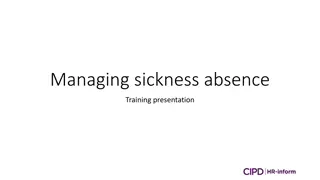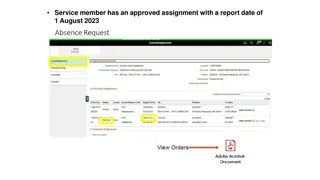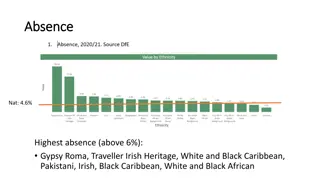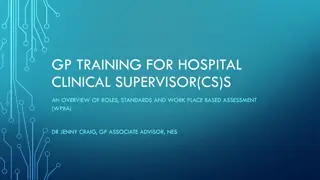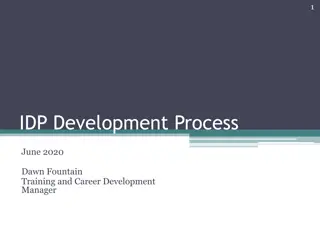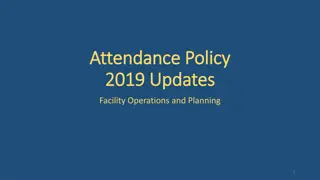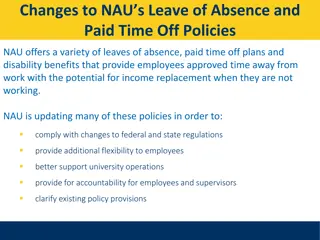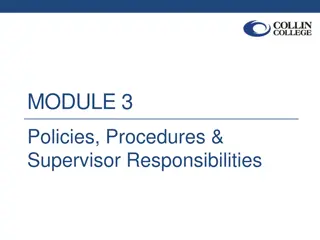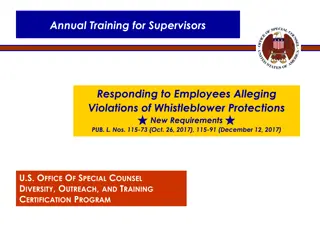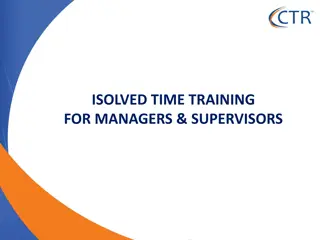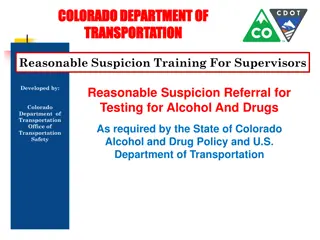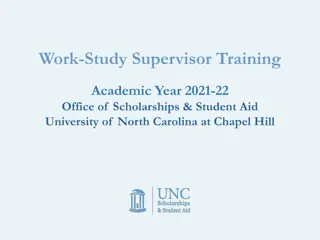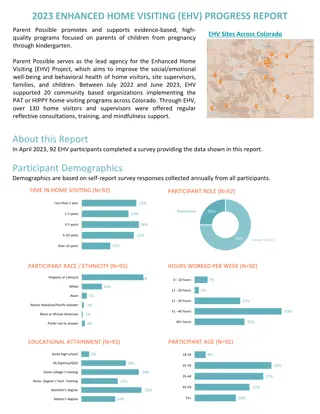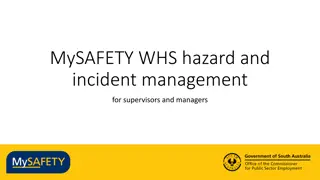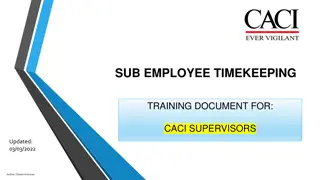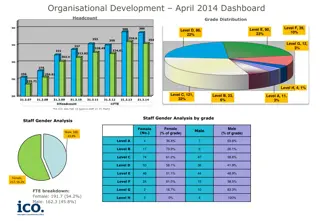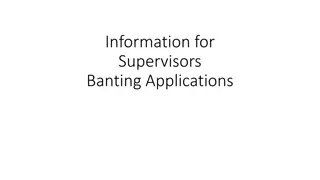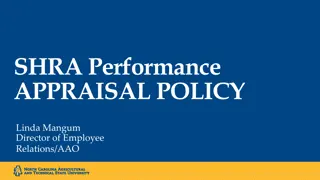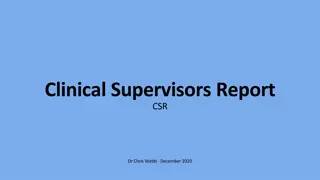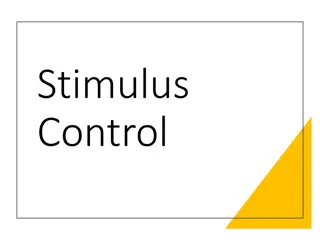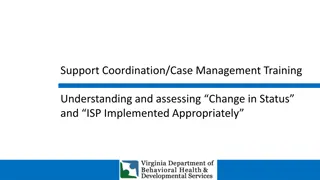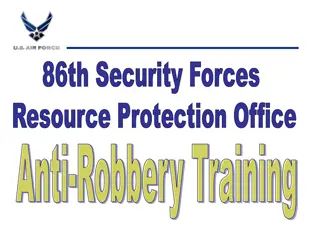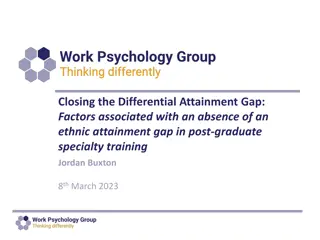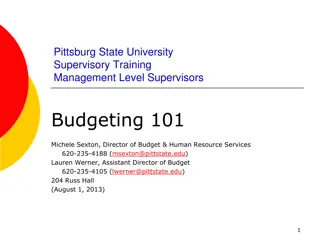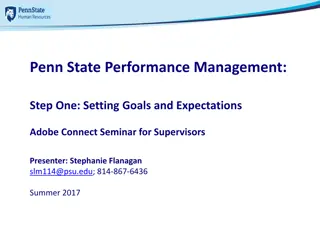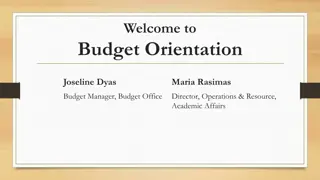Absence Management for Supervisors Online Training
This online training course is designed for commonwealth supervisors to gain an understanding of their role in managing employee absences. Topics covered include roles and responsibilities related to absences, absence management, leaves of absence, and compliance with the Family and Medical Leave Act. Supervisors will learn about employee and supervisor responsibilities in absence management. The course also introduces a classroom training component for further exploration of the topic.
Download Presentation

Please find below an Image/Link to download the presentation.
The content on the website is provided AS IS for your information and personal use only. It may not be sold, licensed, or shared on other websites without obtaining consent from the author. Download presentation by click this link. If you encounter any issues during the download, it is possible that the publisher has removed the file from their server.
E N D
Presentation Transcript
Absence Management for Supervisors An online training for all commonwealth supervisors button2
Welcome to this web-based training on absence administration. This course is for commonwealth supervisors. It will offer you an overview of your role in managing your employees absences. button2 button2
Classroom Course This is a basic course that offers an introduction to the topic of absence administration. After successfully completing this course, you will be enrolled in a classroom course that will explore this information in greater detail. This course will be scheduled by your Human Resource Office. button2 button2
Learning Objectives After completing this course, you should have a basic understanding of the following: Roles related to absences Absence management Leaves of absence Absences under the Family and Medical Leave Act button2 button2
Roles Related to Absences The following slides outline roles and responsibilities in the administration of absence management. They cover the responsibilities of employees, supervisors, and Human Resource staff. button2 button2
Employee Responsibilities Employees have responsibility for the following components of absence management: Maintain and manage accrued and anticipated leave. Budget leave to last the entire year. Be aware that when accrued leave is depleted, additional absences may not be approved. Request absences in advance, when possible. Attempt to schedule absences when they are least disruptive to operations. Obtain/provide supporting documentation when required within requested timeframes. Adhere to established call-off procedures and work rules. button2 button2
Supervisor Responsibilities Supervisors have responsibility for the following components of absence management: Maintain efficient operations. Apply the call-off policy consistently. Ensure all absences are recorded. Ensure eligibility for the requested absence type by checking policies and leave balance quotas. Approve (or deny, if appropriate) requests in a timely manner. Monitor employee absences and counsel employees about leave use as needed. button2 button2
Supervisor Responsibilities (continued) Follow labor agreement requirements for vacation selection. Approve absences consistent with operational needs on a first-come, first-serve basis, if requested outside of the vacation selection period. Carefully consider emergency requests. Remind employees annually of the absence management policies and their responsibility to manage/budget their absences. button2 button2
HR Office Responsibilities Time Advisors have responsibility for the following components of absence management: Ensure all employees receive orientation on absence provisions. Provide guidance to supervisors related to leave requests, including but not limited to: Correct absence coding errors Counsel employees about excessive leave use Monitor absence and other time-related error reports. button2 button2
HR Office Responsibilities SPF Coordinators have responsibility for the following components of absence management: Provide final approval or disapproval for FMLA/SPF (Sick, Parental and Family Care) Absences. Determine employee eligibility and entitlement for FMLA/SPF. Provide timely notifications to employees as required by the FMLA. Ensure absences are coded correctly. Monitor usage to ensure employees are not over-utilizing FMLA/SPF Absence. Review medical documentation to ensure completeness and accuracy. Provide and request follow-up documentation as necessary. Assist employees and supervisors with FMLA/SPF Absence requests. button2 button2
HR Office Responsibilities Labor Relations Coordinators have responsibility for the following components of absence management: Work with supervisors when leave restriction or discipline is necessary. Work closely with SPF Coordinator when issues overlap. button2 button2
To Sum it Up: Employees, Supervisors, Time Advisors, SPF Coordinators, and Labor Relations Coordinators all have roles related to managing absences. button2 button2
Absence Management The following slides review the concept of absence management. You may encounter situations for which these basic rules may not apply. button2 button2
Absence Management The Basics Both supervisors and employees have roles in managing absences from work: Supervisors Employees Should consider employee requests for absences in relation to the need to maintain efficient operations (except when the absence is required by law or union contract to be approved). Should manage absences to not exceed accrued and/or anticipated leave balance quotas. button2 button2
Components of Absence Management Following are several ways that can help ensure effective absence management: Develop a call-off policy. Review absence and attendance policies including the call-off policy on an annual basis with all employees. Remind employees of absence management throughout the year if: call-offs are frequent, a lot of leave is used in relation to available leave, or accrued leave is nearly depleted. Counsel employees about effective use (or misuse) of leave when appropriate. Evaluate operational needs when considering each absence request and approve/deny it as appropriate. Apply absence policy and procedures consistently. button2 button2
To Sum it Up: Both supervisors and employees have roles related to absence management. Supervisors should evaluate operational needs when approving/denying absence requests. A well-communicated call-off policy and counseling when appropriate can help in effective absence management. Employees are responsible for managing their absences to not exceed accrued and/or anticipated leave balance quotas. button2 button2
Leaves of Absence The following slides cover basic information that generally applies to all absences. Keep in mind that some types of absences don t always follow the basic rules. button2 button2
Leaves of Absence A Leave of Absence is any time when an employee is absent from work, with or without compensation. button2 button2
Some Basic Rules All time away from work must be charged to and recorded with an appropriate leave type. Absence policies and procedures should be applied consistently. Absences should be requested in advance, unless circumstances do not permit. Emergency requests for all types of absence should be carefully considered. Any medical information provided verbally or in writing must be kept confidential. Most absence requests should be considered based on operational requirements. button2 button2
Types of Leaves of Absence Each type of leave has a unique absence code. There are many different types of leave, grouped into the following two categories: Accrued or Earned Leave Examples include: Annual Personal Sick Granted only for Qualifying Reasons Examples include: Leave Without Pay Civil Military button2 button2
Did you know that Most absence requests may be disapproved for operational reasons. Note: There are some exceptions, so when in doubt, ask the Time Advisor in the Human Resource Office or the SPF Coordinator. button2 button2
Approving Leaves of Absence All leaves of absence require approval/disapproval. Regardless of the type of leave, supervisors must not approve absences when the reason for the absence is either inappropriate or inconsistent with the policy. button2 button2
Resources for Information To make sure the reason for absence is consistent with the absence code requested by the employee, consult these resources: The applicable union contract Materials provided by the Human Resource Office, including the Absence Types Guide. When in doubt, ask the Human Resource Office staff button2 button2
When a Supervisor Needs Guidance Supervisors should seek guidance from the Human Resource Office when they suspect employees are misusing leave or have unique circumstances that impact their leave use. button2 button2
Indicators of Employees Needing Guidance The following triggers may indicate that supervisors should notify or seek guidance from the Human Resource Staff: Employee requests an uncommon leave type. Employee has an unscheduled absence for five or more consecutive work days. Employee s sick leave use has increased over the last few weeks or months. A conversation is overheard or an employee tells the supervisor of a pregnancy or a serious health condition. Employee is nearing the depletion of paid leave. button2 button2
To Sum it Up: Leave must be requested for all time away from work. Generally, supervisors may disapprove absences due to operational reasons. Be sure to approve the correct absence code. Supervisors should seek guidance from their Human Resource Office in certain situations. button2 button2
FMLA Absences In this section we will review absences that are protected by the Family and Medical Leave Act (FMLA). button2 button2
What is FMLA Absence? An FMLA Absence is a paid or unpaid absence from work with benefits for any of the following reasons: For the employee s own serious health condition as defined by the FMLA. For a qualifying family member s serious health condition when the employee is attending to the medical needs of the family member. For the birth, adoption, or foster care placement of a child. button2 button2
What is FMLA Absence? (continued) For a qualifying military exigency when a qualifying family member is called to active military duty. For the serious illness or injury of a qualifying family member or next of kin who is a military service member. button2 button2
FMLA Eligibility To be eligible for FMLA leave, an employee must have: One year of employment, and Worked 1,250 hours in the twelve months preceding the first absence. button2 button2
Commonwealth Provisions The commonwealth provides these absence provisions and designates the absence as FMLA leave when employees meet eligibility. SPF Absence (Sick, Parental and Family Care) for the serious health condition of the employee or family member and for birth, adoption or foster care placement. Military Exigency Absence for certain reasons when a family member is called to active military duty. Military Caregiver Absence to care for a family member who is injured or seriously ill as a military service member. button2 button2
How does FMLA relate to Absence Management? Despite a supervisor s need to maintain efficient operations, no FMLA/SPF Absence can be disapproved by the supervisor for operational reasons or for any other reason. FMLA and SPF Absence policy must be administered consistently. FMLA/SPF Absences must be recorded correctly and timely. All decisions for approval and disapproval are made by the SPF Coordinator. button2 button2
Additional Responsibilities Related to FMLA/SPF Absence In addition to standard absence management responsibilities, you have the additional responsibilities with FMLA/SPF absences: Comply with the FMLA (federal law). Advise employees of their rights to use FMLA/SPF Absence when absences are suspected to be qualifying. Determine if call-offs should be designated as FMLA/SPF Absence. Contact the SPF Coordinator for assistance and advice on all confirmed or possible FMLA Absences. button2 button2
FMLA Absence Dos and Donts DO ensure that paid absences used for an FMLA qualifying reason are entered with correct absence codes. DON T ignore paid leave absences that may qualify as FMLA. Note: It is inappropriate to allow the use of paid leave and not report it as FMLA leave if it qualifies. DON T allow unpaid FMLA leave to be used simply because paid sick leave is depleted. button2 button2
Confidentiality An employee should submit all medical documentation related to a serious health condition to the SPF Coordinator. Supervisors should not review medical documentation, but should forward it directly to the SPF Coordinator in an envelope marked personal and confidential . Supervisors should maintain confidentiality of any medical documentation or information the employee shares. button2 button2
To Sum it Up: Paid and unpaid SPF, Military Exigency and Military Caregiver Absences are designated as FMLA and protected. Decisions for approval/disapproval of FMLA Absences are made by the SPF Coordinator. Supervisors should contact the SPF Coordinator when an absence may be due to an FMLA reason. Supervisors should maintain confidentiality of all medical information. button2 button2
Questions and More Information Each agency has a designated SPF Coordinator. This person is available to assist with any questions you may have about the FMLA and SPF Absence policy. For additional information about SPF absences, please visit www.spfsupervisors.state.pa.us. button2 button2
Future Training Classroom training will provide more specific information on SPF Absence and all other materials included in the presentation. For questions, contact your Human Resource Office. button2 button2


